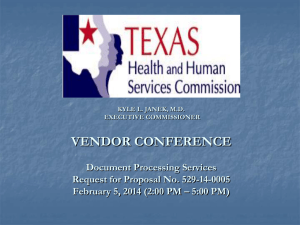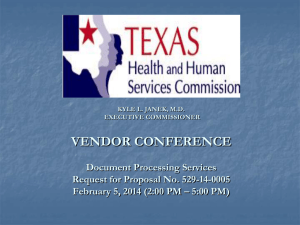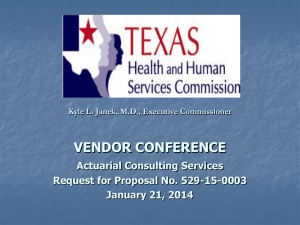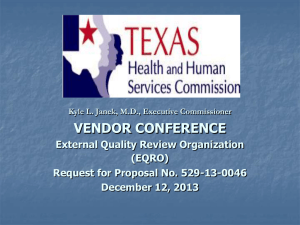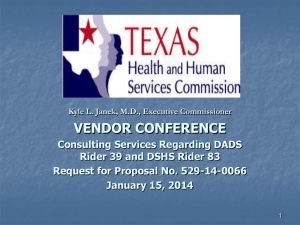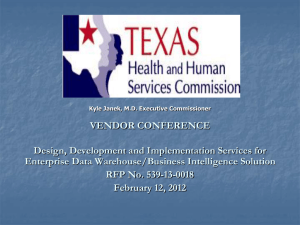Vendor Conference presentation
advertisement
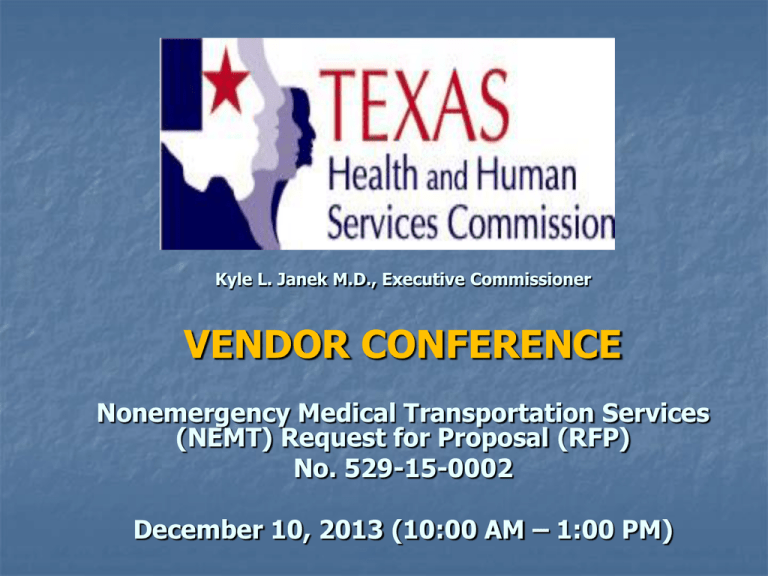
Kyle L. Janek M.D., Executive Commissioner VENDOR CONFERENCE Nonemergency Medical Transportation Services (NEMT) Request for Proposal (RFP) No. 529-15-0002 December 10, 2013 (10:00 AM – 1:00 PM) Welcome Introductions: Chris Traylor, Chief Deputy Executive Commissioner Wayne Wilson, Deputy Executive Commissioner, Richard Blincoe, Procurement Project Manager, PCS Robert Hall, Director for Client Services Procurement/HHS HUB Coordinator, PCS Dimitria Pope, Director, Medical Transportation Program (MTP) Shannon Pickett, Associate Director MTP Rich Stebbins, Director of Finance, 2 Medicaid/CHIP Welcome Introductions (cont.): Rachel Butler, Chief Actuary, Financial Services PJ Fritsche, Director of Health Services System, Information Technology Sherice Williams, HUB Coordinator /Administrator, Procurement and Contract Services (PCS) Kent Hardin, Assistant General Counsel, Office of General Counsel Housekeeping Items 3 Vendor Conference Overview Procurement Activities Program/RFP Overview Financial Overview Capitation Rate Methodology Overview Information Technology and Telecom Overview HUB Overview Legal Overview Question Submittal Break 4 PCS Procurement Activities Sole Point of Contact Source for Questions & Answers Procurement Schedule Solicitation Access http://www.hhsc.state.tx.us/contract/5 29150002/rfp/announcements.shtml Submission Requirements Solicitation Amendments Oversees Screening & Evaluation Process Award Information 5 Procurement Schedule RFP Release Date November 25, 2013 Vendor Conference December 10, 2013 Vendor Questions Due (COB) December 13, 2013 Response to Questions Posted Proposals Due (2:00 PM Central Time) January 15, 2014 Tentative Award Posting March 1, 2014 Anticipated Contract Start Date (est.) (est.) December 19, 2013 July 31, 2014 6 PROGRAM/PROJECT OVERVIEW RFP #529-15-0002 Dimitria D. Pope, Director MTP 7 RFP Mission HHSC’s mission for this procurement is to establish a statewide network of qualified, Managed Transportation Organization (MTO) that will offer quality, safe, timely and economical transportation services to eligible clients that have no other means of transportation to obtain medical care or other health care services. 8 RFP Goals and Objectives Comply with requirements of Senate Bill 8. Establish a qualified MTO in each MTO Region to provide transportation services to eligible clients that have no other means of transportation to obtain medical care or other health care services. Ensure that eligible MTP clients have safe and timely access to transportation services to covered medical care or other health care services. 9 RFP Goals and Objectives (Cont.) Offer quality service that is appropriate and economically feasible based on client health care needs. Increase program efficiencies through the establishment of a regional network of transportation providers. Eliminate potential for fraud, waste and abuse. 10 RFP Goals and Objectives (Cont.) Reduce the cost of medical transportation by utilizing a capitation rate methodology. Increase efficiencies through data analytics collected and reported by providers and analyzed by HHSC. Comply with obligations of the Frew lawsuit. 11 Contract Terms HHSC will award multiple contracts across the State, selecting one vendor per MTO Region. Initial contract period will be for a term of three (3) years with option to extend the term of the contract for up to two (2) additional (1) year terms or as necessary to complete mission of procurement. 12 Contract Terms (Cont.) Vendors may apply for, and may be awarded contracts for, multiple MTO Regions. Vendors must submit separate proposal responses for each MTO Region in which they wish to be considered. 13 Scope of Work Provide a statewide network of qualified regional providers for transportation services that offers quality, safe, timely and economically feasible medical transportation services to eligible clients. Administer and operate the program ensuring vendor and subcontractor compliance and accountability to HHSC for effective and efficient performance. 14 FINANCIAL OVERVIEW Rich Stebbins HHSC-MCD Finance Director 15 Financial Overview Fundamentals of a Capitated, Full Risk contract Financial evaluation of RFP submissions and prospective Vendors Post-award financial performance monitoring & reporting requirements 16 Fundamentals of a Capitated, Full Risk contract How it works: Not based on payment for each service rendered Not based on reimbursement for specific costs incurred HHSC establishes a monthly rate per person, which covers each eligible person living in the MTO’s Region 17 Fundamentals of a Capitated, Full Risk contract How it Works (Cont.): This rate varies by type of person (e.g., under 21), and other factors (urban vs. rural, by Region, etc.); each type is called a rate cell Aggregate monthly payment amount determined by HHSC, by multiplying monthly rate by the quantity of each beneficiary type 18 Fundamentals of a Capitated, Full Risk contract How it Works (Cont.): Aggregate monthly payment will fluctuate depending upon the changes in number (and types) of eligible beneficiaries living in the Region The MTO is then responsible to provide all Contract-required services during the month for that monthly amount 19 Fundamentals of a Capitated, Full Risk contract How it works (Cont.): Some beneficiaries will use no services; MTO is still paid. Some beneficiaries use high degree of services; MTO not paid any extra. 20 Fundamentals of a Capitated, Full Risk contract How it Works (Cont.): Monthly amount paid is also to cover administration, including Contract Deliverables. MTO is responsible for providing all Contract-required NEMT services for every eligible beneficiary living in the MTO’s Region, regardless of where the beneficiary may need to travel. 21 Fundamentals of a Capitated, Full Risk contract How it works (Cont.): The Region defines who an MTO covers; it does not define where an MTO is responsible for providing transportation. Monthly capitation is usually received by MTO about mid-month, for the month covered. This provides some cash-flow advantage for the MTO. 22 Fundamentals of a Capitated, Full Risk contract How it works (Cont.): Monthly cap payments fluctuate primarily by beneficiary population, not by service usage. If usage goes up in a given month, costs will go up, but revenues will not necessarily change. Likewise, if usage goes down in a month, costs will go down, but revenues may not change. 23 Fundamentals of a Capitated, Full Risk contract Other Implications: MTOs may suffer losses if the capitation does not cover all costs. HHSC does not reimburse for any such losses. Capitation rates include a profit component but this is a full risk contract and losses are borne by the contractor. 24 Fundamentals of a Capitated, Full Risk contract Other Implications (Cont.): The MTO should aggressively negotiate provider subcontract rates, and look for administrative efficiencies. Generally speaking, HHSC adjusts rates each year based in large part on a prior period of experience and demonstrated cost trends. 25 Fundamentals of a Capitated, Full Risk contract Other Implications (Cont.): There is a substantial amount of reporting and administration involved. Capable IT and financial staff will be needed on an on-going basis. HHSC dual goal: Vendor solvency and lower costs for taxpayers. 26 Fundamentals of a Capitated, Full Risk contract Other Implications (Cont.): It is in the MTO’s own best interest to develop methods to cut costs, without denying required services to beneficiaries: This would increase an MTO’s profit in a given year. Over the long run, will bring down total costs to HHSC. 27 Fundamentals of a Capitated, Full Risk contract History of capitated full-risk contracts: HHSC has successfully utilized capitated fullrisk contracts for 18 years. HHSC now pays out over $14 Billion annually under these contracts. Many vendors are involved, and they generally apply to sign-up again when contracts expire. 28 Fundamentals of a Capitated, Full Risk contract History of capitated full-risk contracts (Cont.): For NEMT, HHSC has already utilized this approach for the state’s two largest metro areas, which covers approximately 45% of the state’s beneficiary population. Undertaking such a contract is a significant endeavor. 29 Financial evaluation of RFP submissions and prospective Vendors Financial capacity, stability, and track record of prospective Vendors. Negotiating financially-competitive subcontracts with transportation providers. Potential in-house or Affiliate fleets. Vendor strategies for reducing costs. 30 Post-Award Financial Performance Monitoring & Reporting Requirements Why internal MTO costs matter to HHSC: Certain costs are unallowable based on regulation or contract. Historical vendor costs are an important component in the rate-setting process. 31 Post-Award Financial Performance Monitoring & Reporting Requirements (Cont.) Encounter submissions: “Encounters” are electronic records of provider transactions. Encounter data must be sent to HHSC’s agent by the MTO. Encounter data must be highly accurate. 32 Post-award Financial Performance Monitoring & Reporting Requirements (Cont.) Encounter submissions (Cont.): The MTO must have knowledgeable staff to handle this data. Encounters must tie to financial reports, within close tolerances. Encounters will be used in developing future capitation rates. 33 Post-Award Financial Performance Monitoring & Reporting Requirements (Cont.) MTO financial reporting to HHSC: Financial reporting is described in the RFP, and required by the Contract. Most reporting is quarterly and annually, with some “as-occurs” reports. 34 Post-Award Financial Performance Monitoring & Reporting Requirements (Cont.) MTO financial reporting to HHSC: There are a number of different reports, requiring some substantial administrative efforts. Reports include a defined income statement, plus operating metrics, and various disclosures. 35 Post-Award Financial Performance Monitoring & Reporting Requirements (Cont.) HHSC Cost Principles: Financial reporting must conform to HHSC’s Cost Principles document. There are a number of types of costs that are allowable by GAAP and the IRS that are not allowable for inclusion in reports to HHSC. 36 Post-Award Financial Performance Monitoring & Reporting Requirements (Cont.) Experience Rebates: If an MTO earns a pre-tax income of over 5%, then the MTO must rebate back a certain portion that is in excess of the 5% income. Certain offsets may apply, such as a Loss Carry-forward. 37 Post-Award Financial Performance Monitoring & Reporting Requirements (Cont.) Audits: Each annual Financial Statistical Report (FSR) is audited. Liquidated Damages: Potential penalties for misreporting, late reporting or inadequate reporting. 38 CAPITATION RATE METHODOLOGY Rachel Butler, Chief Actuary 39 Capitation Rate Process Overview Generally, under a capitated full-risk model, the Managed Transportation Organization will be paid a predetermined amount, per member per month (PMPM) for each enrolled client in their area. Rates are set annually for the state fiscal year which begins September 1. 40 Capitation Rate Process Overview (Cont.) Rate setting process begins well in advance of the effective date. HHSC in conjunction with HHSC’s external actuarial firm calculates the rates in advance of the effective date. 41 Capitation Rate Process Overview (Cont.) MTOs will be present rates and a meeting will be held to discuss the rate-setting methodology used in determining those rates. MTO’s will be given the opportunity to ask questions and comment on the rates. 42 Capitation Rate Process Overview (Cont.) Additional time will be granted for the MTO’s to draft responses and provide additional information or data they deem necessary for rating. A final meeting will be held with the Executive Commissioner present the MTO’s comments and seek approval of the rates. 43 Capitation Rate Process Overview (Cont.) Rates require approval from the following: HHSC Executive Commissioner Legislative Budget Board Governor’s Office Centers for Medicare and Medicaid Services (CMS) 44 Capitation Rate Methodology Rates are fixed for the rating period. Rates are set by: Geographical service area Risk Group 45 Capitation Rate Methodology (Cont.) Rate Components: Base Data Trend Adjustments for Policy Changes Administrative Cost Risk Margin 46 INFORMATION TECHNOLOGY & TELECOM OVERVIEW P.J. Fritsche, Director Health Services Systems 47 Information Technology & Telecom Overview HHSC IT’s mission is to provide outstanding customer service and innovative technology solutions securely, efficiently and effectively. HHSC IT will support secure file transfers, provide NEMT eligibility and rate files, and support for the Telecom cloud. 48 Information Technology & Telecom Overview (Cont.) HHSC Health Services Systems: Oversees IT Readiness Review. Provides eligibility and capitated rate files via secure transmission. Supports client look up through Texas Medical Transportation System. 49 Information Technology & Telecom Overview (Cont.) IT oversight for vendor and subcontractor compliance to IT standards, including Claims Administrator. HHSC Infrastructure & Operations: Contract oversight for Telecom Cloud implementation On-going support of Telecom Cloud IT oversight for telecom vendor and subcontractor compliance to IT standards. 50 Information Technology & Telecom Overview (Cont.) HHSC provided cloud telecommunications services will include: Toll-free number routing to MTO (IVR) ACD functionality Priority call routing Call center reporting Audio recording 51 Information Technology & Telecom Overview (Cont.) For onsite functionality, HHSC will install and provide the following: Agent phones Cabling to agent stations Voice gateways Network connectivity Remote and onsite maintenance of HHSC provided telephony equipment and cabling Initial training to MTO on ACD reports, audio recording and call monitoring 52 systems Information Technology & Telecom Overview (Cont.) Claims Administrator (Texas Medicaid Health Partnership): Third party vendor responsible for provider enrollment, Encounter Processing, and central secure file transfer via TxMed Central. On-line provider enrollment and lookup. Maintains Electronic Data Interface (EDI) for Encounter submission. 53 HHSC Cloud Telecommunications (Cisco) (877) 633-8747 Clients Data Center Cloud Infrastructure Business Reporting Quality Management Application ACD CTI IVR Dialer WFM Routing Applications • IVR MTO 1 MTO 5 • ACD MTO 3 MTO 2 MTO 6 QM MTO 7 MTO 8 MTO 9 MTO 4 MTO 10 MTO 11 54 Information Technology – Encounters What is an Encounter? Historical record of a claim adjudicated by the MTO for a covered service. Used by HHSC to monitor MTO performance, comply with Federal reporting, and as a component of rate setting. Encounter Record: An electronically formatted list of encounter data elements in a HIPAA compliant transmission. 55 Information Technology – Encounters – EDI X12 837P What is an EDI X12 837P transaction? EDI (Electronic Data Interchange) X12 provides standards for exchanging data between two entities. The 837P is the standard document format for exchanging information about Healthcare Claims/Encounters for Professional services. 56 Information Technology – Encounters – EDI X12 837P (Cont.) What is an EDI X12 837P transaction? (Cont.) HHSC uses the EDI X12 837P version 5010 X222A1 standard as its basis for standardizing the submission of NEMT Encounter Data. Customizations to this standard to support MTO service data are described in the MTO 837P Companion Guide provided by HHSC. 57 Information Technology – Encounters Submission How is Encounter Data submitted to HHSC? MTO IT system will generate files with a maximum of 5000 Encounters compliant with the EDI X12 837P standard and the MTO 837P Companion Guide. MTO’s will submit Encounter Data at least monthly no later than the 30th calendar day after the last day of the month in which the claim was adjudicated. 58 Information Technology – Encounters Submission (Cont.) How is Encounter Data submitted to HHSC? (Cont.) Each MTO will put Encounter files in a predefined secure folder location on TMHP’s Secure FTP server assigned to the MTO. 59 Information Technology – Encounters Processing How are Encounters processed? Encounter files submitted by MTO’s will automatically be picked up for processing and validated for X12 structure compliance. An EDI X12 999 Functional Acknowledgement file will be generated for each file processed and will indicate if the entire file was rejected due to X12 non-compliance. 60 Information Technology – Encounters Processing (Cont.) How are Encounters processed? (Cont.) Files that pass the X12 structure compliance validation will then be validated for compliance with transaction level HIPAA and Business edits. An EDI X12 277 CA (Encounter/Claim Acknowledgement) report will provide the results of this second level of validation and will identify any individual transactions that were rejected. 61 Information Technology – Encounters Processing (Cont.) How are Encounters processed? (Cont.) Accepted Encounter transactions will be stored for review by Texas HHSC. Rejected Encounter files and transactions must be corrected and resubmitted by MTO’s within specified timelines. 62 Encounter Data Secure FTP Folder EDI X12 837P MTO IT System EDI X12 999 EDI X12 277CA Encounter Data Functional Acknowledgement TMHP Encounter System Claim/Encounter Status 63 Historically Underutilized Business (HUB) Requirements Sherice Williams HHSC HUB Coordinator/Administrator 64 Agenda Topics I. RFP Section 4.0 Historically Underutilized Business Participation Requirements II. HUB Subcontracting Plan Development and Submission III. HSP Quick Checklist – Handout IV. HSP Methods – Section 4.6.3-4.6.6 V. HSP Prime Contractor Progress Assessment Report – Section 4.8 65 I. Historically Underutilized Business Participation Requirements 66 I. RFP Section 4.0 Historically Underutilized Business Participation Requirements • HUB Participation Goals – Section 4.3 • Potential Subcontracting Opportunities – Section 4.5 • Centralized Master Bidders List and HUB Directory – Section 4.5 • Vendor Intends to Subcontract – Section 4.6 67 I. RFP Section 4.0 Historically Underutilized Business Participation Requirements (cont.) • Minority or Women Trade Organizations – Section 4.6.6 • Self Performance – Section 4.7 • HSP Changes After Contract Award – Section 4.8 • Reporting and Compliance with the HSP – Section 4.8 68 II. HUB Subcontracting Plan (HSP) Development and Submission 69 If HSP is inadequate, response will be rejected HUB GOALS Special reminders and instructions HSP Information Page 70 III. HSP Quick Checklist ** See Checklist Handout** 71 IV. HSP Methods 72 METHOD OPTIONS A Respondent may choose from one of the following methods when completing the HSP: • Method I – if 100% of your subcontracting opportunities will be performed using only HUB vendors; • Method II – if one or more of the subcontracting opportunities identified will be performed using HUB protégé’s; • Method III – if a combination of HUBs and Non-HUBs are used to perform the subcontracting work identified AND the HUB goal identified in the solicitation is met or exceeded; 73 METHOD OPTIONS A Respondent may choose from one of the following methods when completing the HSP (cont.): • Method IV – if a combination of HUBs and Non-HUBs are used to perform the subcontracting work identified AND the HUB goal identified in the solicitation is not met or exceeded. • Method V - if the Respondent intends to self perform all of the work utilizing their own resources, equipment, employees, and supplies. 74 ALL METHODS For ALL Methods the following steps are required to be completed on the HSP Form: • Page 1 - Section 1 - Respondent and Requisition Information; • Page 2 - Company and Requisition Information • Page 2 - Section 2(a) – Subcontracting Intentions • Section 4 – Affirmation and Sign 75 HSP Information Page Respondent and Requisition Information 76 Company Name and Requisition # Subcontracting Intentions: If Yes, Complete Section 2a If No, Complete Section 2b 77 Section 4; Affirmation Signature Affirms that Information Provided is True and Correct. 78 METHOD I If all (100%) of your subcontracting opportunities will be performed using only HUB vendors, complete: • All of the steps in Slides 76 and 77 • Section 2 b. – List all the portions of work you will subcontract, and indicate the percentage of the contract you expect to award to HUB vendors; • Section 2 c. – Yes; • HSP GFE Method A (Attachment A) – Complete this attachment for each subcontracting opportunity. 79 Complete Section 2-b; List all the portions of work you will subcontract, and indicate the % of the contract you expect to award to all HUBs. Complete Section 2-c; Yes if you will be using only HUBs to perform all Subcontracting Opportunities in 2-b. 80 HSP GFE Method A (Attachment A) Complete this attachment (Sections A-1 and A-2) and List Line # and Subcontracting Opportunity. HUB Subcontractor Selection for this Subcontracting Opportunity 81 METHOD II If any of your subcontracting opportunities will be performed using HUB protégés, complete: • All of the steps in Slides 76 and 77 • Section 2 b. – List all the portions of work you will subcontract, and indicate the percentage of the contract you expect to award to HUB vendors; • HSP GFE Method B (Attachment B) – Complete Section B-1 and Section B-2 only for each subcontracting opportunity as applicable. 82 Complete Section 2-b; List all the portions of work you will subcontract, and indicate the % of the contract you expect to award to HUB Protégés. Skip Sections 2-c and 2-d. 83 HSP GFE Method B (Attachment B) Complete Sections B-1; and B-2 only for each HUB Protégé subcontracting opportunity. 84 HSP GFE Method B (Attachment B) List the HUB Protégé(s) 85 METHOD III If you are subcontracting with HUBs and Non-HUBs, and the aggregate percentage of subcontracting with HUBs in which the HUB Goal identified in the solicitation is met or exceeded , complete: • All of the steps in Slides 76 and 77 • Section 2 b. – List all the portions of work you will subcontract, and indicate the percentage of the contract you expect to award to HUB vendors and Non HUB vendors; • Section 2 c. – No; • Section 2 d. – Yes; • HSP GFE Method A (Attachment A) – Complete this attachment for each subcontracting opportunity. 86 Complete Section 2-b; List all the portions of work you will subcontract, and indicate the % of the contract you expect to award to HUBs and Non-HUBs. Complete Section 2-c; No to using only HUBs to perform all Subcontracting Opportunities in 2-b. 87 Complete Section 2-d; Yes, to the Aggregate % of the contract expected to be subcontracted to HUBs to meet or exceed the HUB goal, which you have a contract agreement in place for five (5) years or less. 88 HSP GFE Method A (Attachment A) Complete this attachment (Sections A-1 and A-2) for each subcontracting opportunity. Subcontractor Selection (HUBs and Non-HUBs) 89 METHOD IV If you are subcontracting with HUBs and Non-HUBs, and the aggregate percentage of subcontracting with HUBs, holding an existing contract with HUBs for 5 years or less, does not meet or exceed the HUB Goal identified in the solicitation, complete: • All of the steps in Slides 76 and 77 • Section 2 b. – List all the portions of work you will subcontract, and indicated the percentage of the contract you expect to award to HUB vendors and Non HUB vendors; • Section 2 c. – No; • Section 2 d. – No; • HSP GFE Method B (Attachment B) – Complete this attachment for each subcontracting opportunity. 90 Complete Section 2-b; List all the portions of work you will subcontract, and indicated the % of the contract you expect to award to HUBs and Non-HUBs. Complete Section 2-c; No, to using only HUBs to perform all Subcontracting Opportunities in 2-b. 91 Complete Section 2-d; No, to the Aggregate % of the contract expected to be subcontracted to HUBs to meet or exceed the HUB goal, which you have a contract agreement in place for five (5) years or less. 92 HSP GFE Method B (Attachment B) Complete Section B-1; and Section B-2 only for each subcontracting opportunity. Good Faith Efforts to find Texas Certified HUB Vendors 93 HSP GFE Method B (Attachment B) Written Notification Requirements List 3 HUBs Contacted for this Subcontracting Opportunity 94 HSP GFE Method B (Attachment B) Written Notification To Trade Organizations 95 HSP GFE Method B (Attachment B) List Trade Organizations Notified with Dates Sent/Accepted. 96 HSP GFE Method B (Attachment B) Provide written justification why a HUB was not selected for this Subcontracting Opportunity 97 METHOD V If you are not subcontracting any portion of the contract and will be fulfilling the entire contract with your own resources (i.e., equipment, supplies, materials, and/or employees), complete: • All of the steps in Slides 76 and 77 • Section 3 – Self Performing Justification 98 Section 3; Self Performing Justification List the specific page(s)/section(s) of your proposal response, OR in the space provided, which explains how your company will perform the entire contract with its own equipment, supplies, materials and/or employees. 99 HUB Subcontracting Opportunity Notification Form 100 Sample for Respondent’s Use. 101 V. HSP Prime Contractor Progress Assessment Report 102 HSP Prime Contractor Progress Assessment Report • Required with ALL Pay Requests • List ALL Sub payments (HUBs & Non-HUBs) • Required even if not subcontracting 103 Legal Overview Kent Hardin, J.D. HHSC Office of General Counsel 104 Legal Overview Statutes and Rules Collusion Apparent or Actual Conflicts of Interest Revolving Door Don’t Skip Details 105 Texas Health and Human Services Commission Question Submittal Texas Health and Human Services Commission Break Texas Health and Human Services Commission Closing Comments 108 Texas Health and Human Services Commission Thank You! 109
